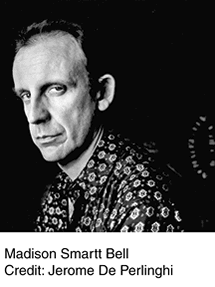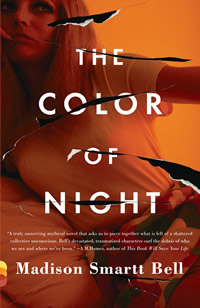Madison Smartt Bell’s connection with Haiti goes back to the mid-1990s, when he wrote All Souls’ Rising, the first in his trilogy of novels about the Haitian revolution. In 2007, he published a biography of Toussaint Louverture, and he is currently at work on a book about another Haitian hero, Jean-Jacques Dessalines. But beyond serving as a subject for his writing, Haiti and its uniquely spiritual culture have also shaped Bell’s approach to life and work. As he wrote recently in The New York Times, he hoped to find in Haiti a way to “drain away my old personality and see if I could get by without forming a new one.” His exploration of Haitian Vodou led to an experience of spiritual possession, and he has come to see the erasure of the self—and service to a spirit—as central to his creative process. In the most recent issue of Granta, Bell wrote, “I want the spirit that moves the story to pass cleanly through me on to the page, thence into the mind of the reader, without any conscious interference from my own personality. Because I get a better story that way.”
 Bell has never acknowledged his reliance on the spirit more frankly than he did with his new novel, The Color of Night, released last spring. In the book’s foreword, he described it as “dictated to me by daemons” and “the most vicious and appalling story ever to pass through my hand to the page.” The Color of Night tells the story of a murderous Las Vegas blackjack dealer named Mae who is inspired by the 9/11 attacks to travel to New York in search of an old lover. Told entirely from Mae’s point of view, the novel filters all the action through her mad vision of herself as a kind of bloodthirsty goddess, somehow made immortal by the brutal abuse she suffered as a child, and by her sojourn with a Manson-like cult in youth. The book is unflinching in its depiction of erotic violence. Mae feels no sympathy or sorrow for her victims, and she glories in the mass death at the twin towers.
Bell has never acknowledged his reliance on the spirit more frankly than he did with his new novel, The Color of Night, released last spring. In the book’s foreword, he described it as “dictated to me by daemons” and “the most vicious and appalling story ever to pass through my hand to the page.” The Color of Night tells the story of a murderous Las Vegas blackjack dealer named Mae who is inspired by the 9/11 attacks to travel to New York in search of an old lover. Told entirely from Mae’s point of view, the novel filters all the action through her mad vision of herself as a kind of bloodthirsty goddess, somehow made immortal by the brutal abuse she suffered as a child, and by her sojourn with a Manson-like cult in youth. The book is unflinching in its depiction of erotic violence. Mae feels no sympathy or sorrow for her victims, and she glories in the mass death at the twin towers.
Not surprisingly, The Color of Night received a somewhat mixed response. As Bell said in an interview with Chapter 16, “If you have your protagonist exulting in the fall of the World Trade Center on page one, you can count on upsetting a few people,” and the book did indeed meet with resistance early on, finding an American publisher only after it had been sold in France.
Once the book was launched, much of the media attention focused on Bell’s unusual ideas about writing, including an interview with The New Yorker in which Bell offered a how-to guide for entering a creative trance. Bell also weighed in at The Huffington Post with some thoughts about the nature of violence in American culture.
 Critical reception to the book itself ranged from enthralled to repelled, sometimes, as with The Washington Post, within a single review. Here at Chapter 16, we were impressed by the way Bell “conveys Mae’s wild vision so beautifully that the reader is carried along unresisting.” The folks at the online literary journal The Nervous Breakdown nominated The Color of Night for a “Nobbie” as one of the best books of 2011, alongside such critics’ darlings as Joan Didon’s Blue Nights and Justin Torres’s We the Animals. TNB praised the book as “beautifully written,” and declared that “The Color of Night accomplishes one of the most difficult things a writer can attempt: it makes potentially repellent subject matter entertaining.”
Critical reception to the book itself ranged from enthralled to repelled, sometimes, as with The Washington Post, within a single review. Here at Chapter 16, we were impressed by the way Bell “conveys Mae’s wild vision so beautifully that the reader is carried along unresisting.” The folks at the online literary journal The Nervous Breakdown nominated The Color of Night for a “Nobbie” as one of the best books of 2011, alongside such critics’ darlings as Joan Didon’s Blue Nights and Justin Torres’s We the Animals. TNB praised the book as “beautifully written,” and declared that “The Color of Night accomplishes one of the most difficult things a writer can attempt: it makes potentially repellent subject matter entertaining.”
You can find an excerpt from the book here at Chapter 16 and find a sample of Bell’s new novel-in progress at Granta. Below are a few more examples of critical kudos for this provocative, original book.
“It’s all very eerie, and all very well told. … Mr. Bell is one of those writers who can’t write a bad sentence, which keeps you reading even when the scene at hand is repellent. He is very good at re-creating the very bad.” ~review inThe Washington Times
“Certainly Bell takes the reader on a twisted journey, but Mae is both believable and fascinating—and the trip is thrilling.” ~Associated Press review in The Seattle Times
“Bell does something difficult with this work. He looks at what gives birth to violent people. … Bell’s story is taut, searching, daring and, yes, appalling.” ~review in The Oregonian
“With a bleak nod to Cormac McCarthy, ‘The Color of Night’ often reads like a hybrid of ‘The Electric Kool-Aid Acid Test’’ and ‘Helter Skelter.’” ~review in The Boston Globe
“Hemingway always wrote about himself; the protagonist is a variation on Ernest Hemingway. … I’m way more interested in what trying to understand what it’s like to be other people.” ~Madison Smartt Bell in a YouTube profile
For more updates on Tennessee authors, please visit Chapter 16’s News & Notes page, here.
Tagged: Fiction





